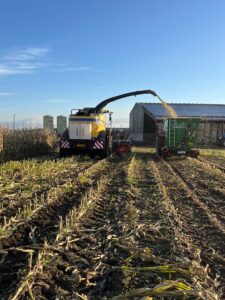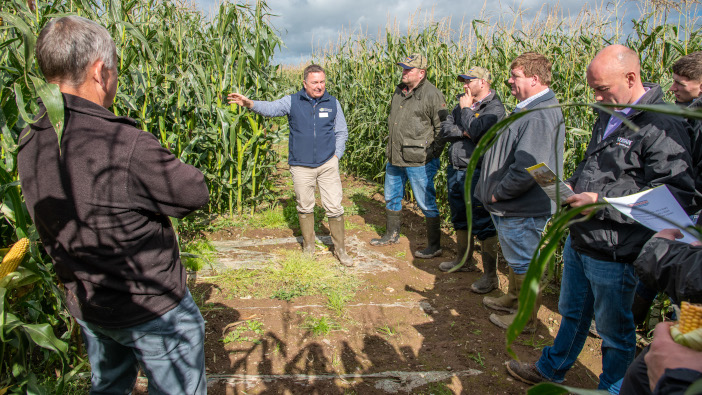Hutchinsons’ northern maize trials have highlighted the importance of tailoring variety to the desired drilling date.
Hosted by the Fisher family, near Carlisle, the trials featured 30 new and established varieties, with some grown under plastic, enabling comparisons to be made between the agronomic traits and the yield potential.
Poor weather was a key factor this year, with drilling pushed back to 8 May and harvesting not taking place until mid-October.
Agronomist Jim Clark says: “Generally, that reflects what we saw in the field this season too, and in such a challenging year, anything that helped crops establish quickly really stood out in terms of the results.”
The importance of variety
Jim notes that the differences in varieties, especially the speed of establishment and maturity, were evident this year.
“In many cases, there was a 10-week drilling window for maize from April to the first week of June, which really proved that growers have to pick the best varieties for when they want to drill. There are some good varieties available, we just have to fine-tune choices more.”
While the weather remains an unpredictable factor, the trials showed how important it is to match the variety to the timings, and vice versa.
“Growers have often tried to push varieties to the limit of what they can do, but maybe this year was a wake-up call to be a bit more realistic, in the North at least.”
He highlights P7034, which remained a big seller due to its high rumen-degradable starch content. In contrast, P7326 has dropped in popularity despite being one of the earliest maturing varieties when grown under film. Making it a potential option in late sowing situations.
“If you are forced to drill a week or two later, or you’re on heavy land and know you’ll want to get the crop off early, then it does pay to go for an earlier maturing variety such as P7326.”
In the trials, Bayer varieties (DKC3204 and DKC3218) stood out for their early vigour and were popular with visitors. Results also suggest that these mature slightly earlier than their FAO ratings suggest.
“For instance, DKC3204 has a rating of 210, but from what we’ve seen in the field, while it is slightly later, we think it’s actually closer to P7034, which is rated nearer 180-190.”
 Open crops
Open crops
Jim notes that the open field crops suffered significant damage from rooks and seagulls, making it difficult to truly assess yield results. However, when combined with previous data, Prospect is shown to be a good performer.
“It’s not mega early, more of a 170 than a 150 or 160, but it’s quite vigorous out of the ground and we can normally get crops to maturity in good time. A lot of growers like Prospect purely because if the weather’s ok, it’s just a bit bigger than the ultra-early varieties, and might push 16-18 t/acre, which is at the limit of what we can do in the open.”
However, it can falter when grown under plastic. “We think the cut-off for sowing crops in the open is around 10-15 May up here. If you’re drilling after that, you should go back to putting maize under film to help crops catch up. Prospect isn’t best suited to that situation [under film], so you are better going with a variety like P7179 or P7326.”
Benefits of placement fertiliser
One key result from the trials was the benefit of placement phosphorus fertiliser, which can help maize establish strongly, both in open crops and under film.
Jim explains that a smaller quantity of microgranules placed with the seed can offer cost savings over traditional DAP applications, with improved nutrient use efficiency to help rooting, establishment and yield potential.
In the trial, DKC3204 sown with Primary-P went on to produce 1.22t/ha of dry matter more than the same variety sown without. At a milk price of 45p/litre, this could be worth an additional £887.20/ha.
Crystal Green also provided a yield benefit, said to be worth £700/ha.
“A lot of local contractors are now getting on board with placement fertiliser, and many say it is also easier to use than DAP,” notes Jim.
Undersowing
The undersowing trials highlight the difference in sowing rates and establishment methods. Using disc drills reportedly worked well, however this had to be balanced with the correct variety.
Because grass must be sown before the maize gets too large, sowing a vigorous Westerwold mix can lead to the undersown crop becoming too big.
“If we’re going to use mechanical drills to sow grass in maize early, we’ll probably have to look for a slower-maturing grass.
“In contrast, where the Westerwold mix is broadcast into standing maize as late as you can travel through with a fertiliser spinner, we need that vigour because the grass is going in so much later and has to reach a certain size before maize shades it out.”
It’s also important to recognise any risks from pre-emergence grassweed herbicides. “You want as big a gap between herbicide application and sowing the grass as you can get. That window wasn’t massive this year, because once the maize gets too large, you can’t use a mechanical drill. It’s a tricky balance.”
For seed rates, Jim says that 7.5-10 kg/ha of Westerwold did provide reasonable cover, but for farmers wanting to graze land with sheep once maize is taken off, rates should be nearer 17-20 kg/ha.
He also adds that while sowing into maize stubble has become popular for Sustainable Farming Incentive actions, these crops will not be suitable for grazing until the new year, while grass which is undersown or broadcast into the standing crop is far more advanced.



